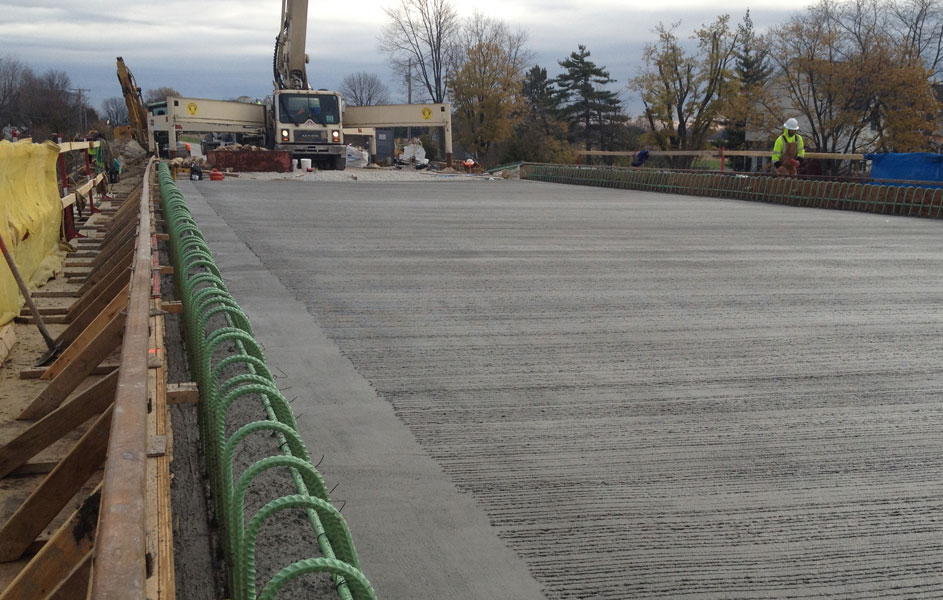January 5, 2023
EDC-7: Sustainable Infrastructure
EDC-7 will feature three innovations that promote sustainable infrastructure. These innovations help quantify greenhouse gas (GHG) emissions, provide tools for managing GHGs over a project lifecycle, and enhance the durability of concrete through internal curing.
EPDS FOR SUSTAINABLE PROJECT DELIVERY
Environmental Product Declarations (EPDs) are tools that can clarify the environmental impacts of construction materials. Transportation agencies continually assess and choose materials or technologies to meet their needs. As State DOTs become increasingly conscious of infrastructure's environmental burdens and seek more sustainable strategies, they are looking for measures that accurately reflect the environmental impacts of each alternative. EPDs communicate the greenhouse gas (GHG) emissions of construction materials in a transparent and standardized manner. They also provide an opportunity to reduce negative environmental impacts by transforming the project delivery process.
What exactly does an EPD tell us? The manufacture and production of construction materials such as aggregate, asphalt, cement, asphalt mixtures, concrete mixtures, and steel reinforcement generates various environmental impacts. An EPD is a verified report used to communicate those impacts from resource use, energy, and emissions. EPDs are developed using life-cycle assessment (LCA) procedures, follow the industry consensus methodology, and undergo third-party verification before being published. Agencies can leverage EPDs to support decision-making throughout project delivery. EPDs requested at material installation can establish benchmarks and develop performance metrics for the material or project. This tool can help agencies reduce GHG emissions in their construction projects.
EPDs offer several benefits to agencies. First, they encourage the demand and supply of products that promote the more sustainable use of resources and create less stress on the environment. Additionally, EPDs provide critical information for LCAs or other types of environmental assessment of alternative design decisions. This allows for meaningful comparisons of environmental performance between materials fulfilling the same function. Finally, EPD data can be included in asset management system databases to perform network-level LCAs and identify areas for environmental performance improvement.
Stay up-to-date on EPDs For Sustainable Project Delivery. Subscribe to EPD e-News to receive updates on webinars, case studies, videos and more.
To learn more about EPDs for Sustainable Project Delivery, please contact LaToya Johnson, or Migdalia Carrion, FHWA Office of Infrastructure.
Integrating GHG Assessment and Reduction Targets in Transportation Planning
Transportation is the largest emitter of greenhouse gases (GHGs) in the United States - as well as one of the fastest-growing sources. National inventories suggest the transportation sector generates approximately 29 percent of the Nation’s GHG emissions, and roadway vehicles account for about 83 percent of that amount. By implementing the Integrating GHG Assessment and Reduction Targets in Transportation Planning initiative, agencies can act now to help decrease future emissions, work toward meeting national reduction goals, and reduce their climate impact.
State DOTs and metropolitan planning organizations (MPOs) play essential roles in implementing policies, programs, and projects that can reduce GHG emissions, not only directly from motor vehicles, but also life-cycle emissions from construction and embodied carbon of materials. DOTs and MPOs can address GHGs in the planning process based on vetted, state-of-the-practice examples. These approaches include specific analytic tools, methods, and frameworks to support target setting and GHG estimation that can be integrated with existing planning products, including statewide and metropolitan transportation plans and transportation improvement programs. They can also support planning for programs such as the newly established National Electric Vehicle Infrastructure Program and Carbon Reduction Program.
One major benefit of Integrating GHG Assessment and Reduction Targets in Transportation Planningis these strategies are adaptable to all agency sizes or technical capacities. The tools and best practices can help any agency take steps toward integrating GHG emission consideration into existing planning structures. This innovation also provides practical mitigation strategies that can impact GHG emissions throughout a project’s life cycle. Finally, the tools and practices can help agencies align GHG reduction goals with strategies to help them achieve progress in meeting targets.
Stay up to date on Integrating GHG Assessment and Reduction Targets in Transportation Planning and subscribe to Integrating GHG e-news. To learn more about Integrating GHG, please contact David D'Onofrio, FHWA Office of Natural Environment, or Jim Thorne, FHWA Office of Planning.
ENHANCING PERFORMANCE WITH INTERNALLY CURED CONCRETE (EPIC2)
Shrinkage cracking in concrete is a key issue for long-term performance in concrete bridges, roads, and repairs. When this cracking occurs early on, it leaves the concrete and embedded reinforcement exposed to degradation, reducing the service life of the structure.

Internal curing increases concrete's resistance to early cracking. (Credit: FHWA)
Enhancing Performance with Internally Cured Concrete (EPIC2) promotes internal curing, which increases concrete's resistance to early cracking, allowing the production of higher-performance concretes that may last more than 75 years. Unlike conventional curing where water is supplied on the concrete's surface, internal curing provides a source of moisture from inside the concrete mixture, improving its resistance to cracking and overall durability.
Over the last 30 years, extensive studies have shown that internal curing addresses the root cause of self-drying shrinkage that is particularly problematic in lower water-to-cementitious materials ratio concretes. This technology can be used in any concrete mixture with an adjustment to mixture proportions.
The most widely used internal curing approach includes pre-wetted lightweight aggregates, which have a high-absorption capacity and are naturally compatible with common concrete production practices. The pre-wetted lightweight fine aggregate replaces a portion of the normal-weight fine aggregate. The saturated, porous fine aggregates distribute the curing water throughout the concrete. As the concrete loses water, water is pulled out of the lightweight aggregate and creates internal curing.
EPIC2 offers agencies several benefits. This innovation can be implemented anywhere traditional concrete is used. Agencies that use this process will help mitigate shrinkage cracking, which improves concrete durability. Additionally, internally cured concrete mixtures can last several times longer than traditional concretes, reducing rehabilitation or replacement needs over a structure’s life-cycle, which results in life-cycle cost-savings. Finally, internally cured concrete mixtures can be designed with lower water-to-cementitious materials ratios and increased use of natural, waste, or alternative recycled cementitious products without reduced performance or increased risk of cracking.
Stay up to date on EPIC2 and subscribe to EPIC2 e-news. To learn more about EPIC2, please contact Tim Barrett, FHWA Turner-Fairbank Highway Research Center.
Stay Up to Date on the EDC Innovations That Interest You Most

EDC teams are always on the move! If you blink, you could miss out on important webinars, case studies, tools, videos, and more. To never miss information for the EDC innovations that interest you most, visit the subscription page and select the topics you’d like to receive updates on directly from the teams that coordinate them.
Recent bulletins:
Strategic Workforce Development 1/3/2023
UHPC 1/2/2023
Local Aid Support 12/20/2022
About EDC
Every Day Counts, a state-based initiative of the Federal Highway Administration's Center for Accelerating Innovation, works with state, local and private sector partners to encourage the adoption of proven technologies and innovations to shorten and enhance project delivery.
EDC News is published weekly by the FHWA Center for Accelerating Innovation.
Notice:The U.S. Government does not endorse products or manufacturers. Trademarks or manufacturers' names appear in this presentation only because they are considered essential to the objective of the presentation. They are included for informational purposes only and are not intended to reflect a preference, approval, or endorsement of any one product or entity.
Recommended Citation:
U.S. Department of Transportation, Federal Highway Administration
EDC News; January 5, 2023
Washington, DC
https://doi.org/10.21949/1521899


